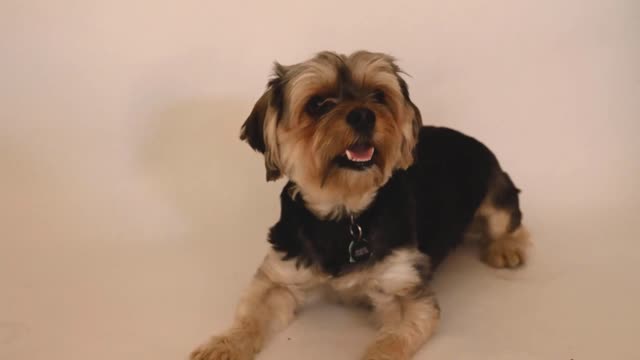Premium Only Content

Dogs in the ancient world.
Dogs in the ancient world.
Dogs have been part of the history of humans since before the written word. The ancient temple of Gobekli-Tepe in Turkey , dating back at least 12,000 years BC, has provided archaeologists with evidence of domesticated dogs in the Middle East, matching the earliest evidence of domestication, the Natufian tomb (c. 12,000 BC) discovered in Ein Mallaha, Israel , in which an old man was buried with a puppy.
In southern France, footprints of a child walking next to a canine were preserved in the earth of Chauvet Cave, dating back 26,000 years and a 2008 EC study concluded that dogs were domesticated in Europe between 32,000-18,800 years ago with the oldest. dog remains in the world found so far dated to 31,700 years ago (Viegas, 1). This Paleolithic dog most closely resembled a Siberian Husky (Viegas, 1). The findings of the 2008 study are challenged by dog remains found in the caves of Goyet, Belgium, that date back 36,500 years.
However old the first dog was, or how they were domesticated, they became friends with humans very early in history and remained so. In many cultures of the ancient world, dogs figured prominently and, for the most part, were regarded in much the same way they are today. Dogs were seen as faithful companions, hunters, guardians, spirit guides, and as a treasured part of the family.
In the oldest Near Eastern story , The Epic of Gilgamesh from ancient Mesopotamia (dated 2150-1400 BC), dogs appear in a high role as companions to one of the region's most popular goddesses; the goddess Innana ( Ishtar ) travels with seven prized hunting dogs on her collar and leash. Although Egypt is credited with the invention of the dog collar, it probably developed in Sumer .
It can be assumed that the development of the dog collar was suggested soon after the domestication of dogs, which happened in Mesopotamia before Egypt. A golden pendant of a dog (clearly a Saluki) was found in the Sumerian city of Uruk dated 3300 BC and a cylindrical seal from Nineveh (dated c. 3000 BC) also features a Saluki. The dog pendant wears a wide collar; evidence of the dog collar in use at that time.
In the famous Descent of Innana (a story considered older and not part of Gilgamesh) in which the goddess descends into the underworld, her husband, Dumuzi, keeps domesticated dogs as part of his royal entourage. Dogs figured prominently in the daily life of the Mesopotamians.
Dogs are depicted in Mesopotamian art as hunters, but also as companions. Dogs were kept at home and were treated the same way by loving families as they are today. Inscriptions and inlaid plates depict dogs waiting for their owners and, according to historian Bertman, even listening to their master playing music: a shepherd playing his flute while his dog sits and listens intently.
Dogs were also associated with divinity by the ancient Persians. The Avesta (Zoroastrian scriptures) contains a section known as Vendidad , which describes the beneficial aspects of the dog, how dogs should be treated, penalties for those who abuse dogs, and how such abuse - or, conversely, care - will affect one's ultimate fate in the afterlife. Indeed, dogs were said to guard the bridge between the world of the living and the dead; how someone treated a dog in their lifetime affected their chances of reaching heaven.
The dog's connection to the gods and the dog's loyalty to humans is explored in other cultures. In ancient Egypt the dog was connected to the jackal dog god, Anubis , who guided the soul of the deceased to the Hall of Truth where the soul would be judged by the great god Osiris .Domesticated dogs were buried with great ceremony in the temple of Anubis at Saqqara and the idea behind this seemed to be to help the deceased dogs pass easily into the afterlife (known in Egypt as the Juncos Field ) where they could continue to enjoy their life. life as they had on earth.
The best known dog buried in this way is Abuwtiyuw, who was honored with a large burial in the Ancient Empire (c. 2613-2181 BC) near the Giza plateau .
Clearly, the dog was an important part of Egyptian society and culture, but so was ancient Greece. The dog was the Greeks' companion, protector and hunter, and the pointed collar, so well known today, was invented by the Greeks to protect the necks of their canine friends from wolves. Dogs appear in Greek literature from the very beginning in the figure of the three-headed dog Cerberus who guarded the gates of Hades .
In ancient India, Mesopotamia, China, Mesoamerica, and Egypt, people had deep bonds with their dogs, and as seen, this was also common in ancient Greece and Rome. The ancient Greeks thought of dogs as geniuses, as "possessing a certain high spirit.
-
 0:58
0:58
Invention with Brian Forbes
3 years agoWorld Mythology and Ancient Myths
15 -
 1:09:26
1:09:26
Dear America
2 hours agoFAKE NEWS GOING TO JAIL!! They Are LYING About Iran And We Can Prove It!
145K102 -
 LIVE
LIVE
Badlands Media
8 hours agoBadlands Daily: June 26, 2025
4,765 watching -
 LIVE
LIVE
Wendy Bell Radio
6 hours agoOBLITERATED
9,409 watching -
 45:17
45:17
Randi Hipper
1 hour agoUSE BITCOIN FOR YOUR MORTGAGE! MAJOR NEWS
1.9K -
 LIVE
LIVE
FusedAegisTV
18 hours agoPersona 5X Worldwide Release! FIRST LOOK | New Gacha
98 watching -
 LIVE
LIVE
LumpyPotatoX2
38 minutes agoHunting the Showdown - #RumbleGaming
36 watching -
 22:05
22:05
The Rad Factory
2 hours agoMy F1 Caught Fire at the Race Track
2.47K1 -
 LIVE
LIVE
The Mike Schwartz Show
2 hours agoTHE MIKE SCHWARTZ SHOW with DR. MICHAEL J SCHWARTZ 06-26-2025
115 watching -
 LIVE
LIVE
GloryJean
1 hour agoMnK Aggressive Games & WINS 🖱️ 6.7 K/D
50 watching